| | Pre-emergence rolling | Post-emergence rolling | Timing of post-emergence weed control and rolling | Late spring frosts/wind damage and land rolling | Summary
Pulse production in Western Canada has made land rolling a common practice on the farm. Land rolling is done to ease harvest operations as well as aid in producing a high quality pulse crop.
There is limited research on land rolling of pulse crops. Three trials have been completed in western Canada: one on lentil in Saskatchewan, one on field pea in Alberta and one on dry edible bean and pea in Manitoba. Pulse crop growers have also provided their experience on land rolling of pulse crops.
Pulse crop fields are rolled for a number of reasons:
- to provide a smooth and level surface (push down soil ridges) for faster, easier harvest operations and better seed-to-soil contact
- to push down stones to reduce guard and sickle section breakage as well as expensive "internal" combine damage
- to allow the cutter bar to get closer to the base of plants to reduce yield losses
- to reduce "earth tag" or soil on the seed, thereby improving quality
- to aid in the harvest of short stature crops; land rolling works especially well under drought conditions
- to allow for an easier adjustment and operation of lifter fingers
- to aid in the harvest of lodged pulse crops and pulse-cereal mixtures for silage
For rolling fields, the steel cylinder land roller is the most common roller used (Figure 1). However, if the land does not have rocks, a harrow packer (coil, spiral) draw bar is a viable option to the land roller. Harrows (tooth and tine) can break lumps and firm soil, but do not push rocks down and are not recommended for pulse crops, which may lodge.
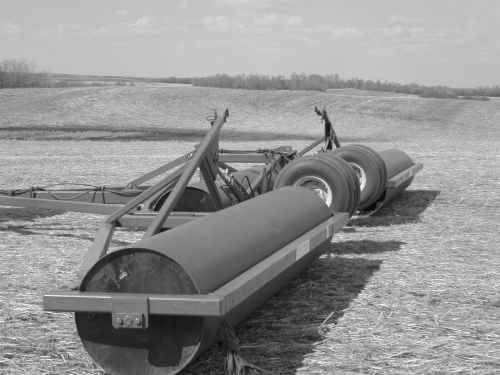
Figure 1. Roller used for land rolling pulse crops.
Pre-emergence Rolling
Pre-emergence rolling for pulse crops is the preferred approach, as opposed to post-emergence, with certain exceptions. Pre-emergence rolling is not recommended under the following conditions:
- extremely wet conditions on clay soils or clay soils with low organic matter that are prone to crusting
- sandy soils, which are prone to erosion
- dry soils, which are prone to wind erosion
- peat soils
Farmers should be careful not to double roll areas of the fields, such as headlands, because excessive plant damage and packing can occur from tractor tires. Rolling the field round and round will eliminate this problem, although there will be areas of the field left unrolled.
Chickpea, dry bean, and fababean fields are not usually rolled after emergence. For chickpea, rolling after emergence (especially under moist conditions) will spread the devastating disease ascochyta blight. Also, chickpea and fababean develop turgid, stiff stems early in their development, and rolling can cause mechanical (breakage) injury to the plants. The rolling of fababean fields is not necessary because of the higher pod location from the soil surface and the good, complete standability of this crop.
For edible beans and soybeans, the hypocotyl elongates (Figure 2), whereas in field pea, it is the epicotyl. The hypocotyl hook is more rigid when compared to the epicotyl in field pea, which is pliable. If the hypocotyl's hook is within half an inch of the soil surface or the crop is 3 to 5 days after emergence, growers should not roll dry bean. Similarly, if the soil is cool at seeding time, growers should wait a couple of days before rolling so as not to seal off the oxygen diffusion rate to the seed, which enhances germination.
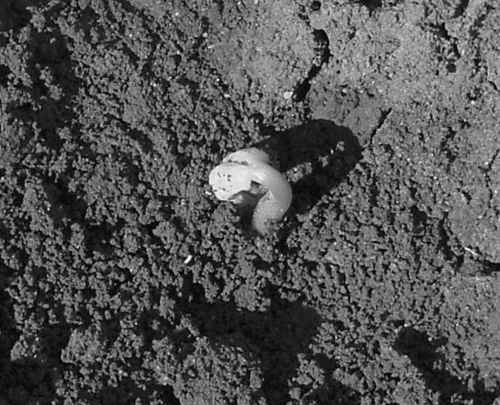
Figure 2. Hypocotyl arch of emerging dry bean seedling.
Post-emergence Rolling
The use of post-emergence rolling depends on the pulse species. Field pea and lentil may be rolled after emergence, although pre-emergence rolling is preferred. When faced with the choice to either spray early or roll early, growers should know that spraying first is recommended instead of rolling. Early weed removal, especially under higher weed pressures, will result in higher yields.
Research on rolling of field pea fields compared to a check field pea crop (not rolled) showed a trend to lower yields (although not statistically significant) with full water ballast (heavy). See Figure 3. A late rolling (2- to 3-node stage) without water ballast (light) did not reduce field pea yield in either year.
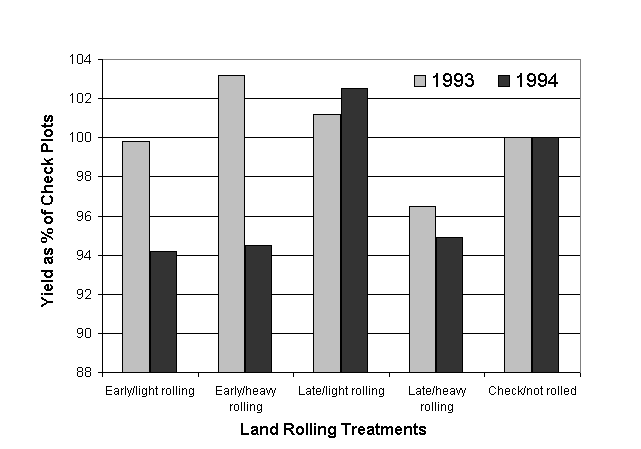
Figure 3. Effects of rolling pea fields.
Note: Early rolling was done immediately after seeding, and late rolling was at the 2- to 3-node stage. Light rolling was a 42-inch roller without water ballast while the heavy rolling was with the water ballast.
Source: Lopetinsky, K. J. and APGC - Zone 3 FFF-OFD #93-F001-5
Research on lentils indicates that land rolling after the emergence of lentil can be successfully completed up to the 5- to 7-node stage without significant yield loss in large-seeded lentil varieties, such as Laird, and the 7-node stage in small seeded varieties (Figure 4.)
Rolling the lentil crop after a rain or heavy dew can uproot small lentil seedlings and increase the risk of soil compaction or the spread of ascochyta blight and anthracnose.
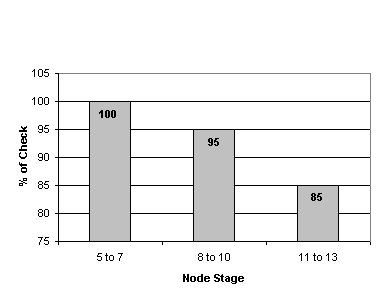
Figure 4. Effect of post-emergence land rolling on Laird lentil seed yield.
Source: Whatley, 1993.
Research on dry bean and field pea found no significant differences due to the rolling treatments or the interaction between rolling treatment and crop type on a stony clay loam at Arborg, Manitoba, in 1998 (Figures 5 and 6). The rolling treatments were:
- no rolling (check)
- rolling immediately after seeding
- rolling during the hypocotyl arch stage - 3 to 5 days after emergence (DAE)
- rolling after the hypocotyl arch stage -10 to13 DAE
However, there were visual observations of broken hypocotyl arches in dry bean rolled 3 to 5 days after emergence. The researchers concluded that for dry bean, rolling should be completed right after seeding or after the hypocotyl arch has straightened itself.
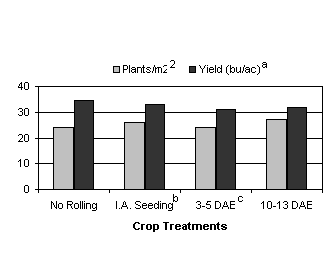
Figure 5. Effect of four rolling treatments on dry bean production
a 60 bushel weight used for dry pea and bean
b I.A. Seeding - Immediately After Seeding
c DAE - Days After Emergence
Adapted from: Klassen, E.P. and Watt, J., 1998
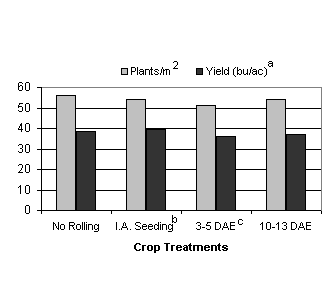
Figure 6. Effect of four rolling treatments on dry pea production.
a 60 bushel weight used for dry pea and bean
b I.A. Seeding - Immediately After Seeding
c DAE - Days After Emergence
Adapted from: Klassen, E.P. and Watt, J., 1998.
Timing of Post-emergence Weed Control and Rolling
Producers who miss their pre-emergence rolling of pulse crop fields often ask, "Do I spray weeds first or roll the field first?" Pulse crops are poor competitors with weeds. Early emerging weeds out-compete the slow-to-emerge and slow-to-canopy pulse crop.
Agriculture and Agri-Food Canada researchers in Lacombe and Lethbridge found field pea yield declined for every week that spraying was delayed after emergence. Waiting 4 weeks after emergence resulted in a 25 per cent penalty in yield (Figure 7.) Not rolling a field pea crop should not result in a significant yield loss.
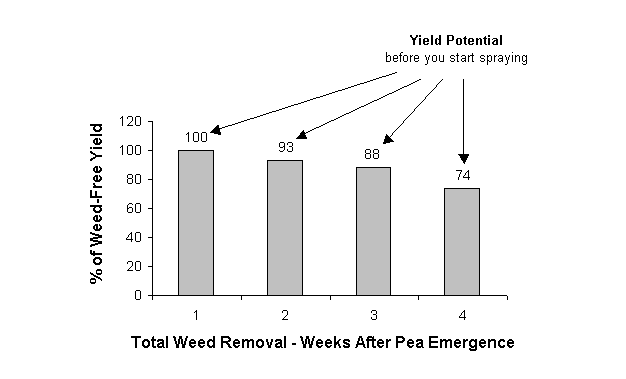
Figure 7. Five site-years: Lacomobe and Lethbridge
Source: Harker, H. N, Clayton, G., and Blackshaw, R., 2001.
Post-emergence rolling before spraying, especially in dry soil conditions, may result in dust on the plant foliage reducing herbicide absorption and plant photosynthesis or growth. Mechanical damage to field pea plants can also affect the ability of the pea plant to metabolize the herbicide into harmless by-products in the plant as well as decrease the weed's ability to translocate or move the herbicide into itself. The bottom line: the benefits of spraying first outweigh the risks of rolling first.
Late Spring Frosts/Wind Damage and Land Rolling
A late spring frost can damage pulse crop seedlings. Pea, lentil and chickpea seedlings can regrow from scale nodes at or just below the soil surface if the primary shoot has been damaged or killed. Post-emergence land rolling of pulse crop seedlings that have been stressed or damaged by adverse environmental conditions can increase seedling losses.
Varieties
Many newer field pea varieties have better standability; if the pre-emergent rolling window is missed and the field is relatively stone free, not rolling may still be acceptable. Additionally, harrow packer bars behind airseeders can often leave a sufficiently smooth field finish.
Long vine, tall varieties (greater than 75-80 cm) and tall forage pea types have a higher tendency to lodge especially under conditions of rain and high winds before harvest. For this reason, rolling fields when growing these types of pea is well worth considering.
Packing pressure
Other questions pulse growers often ask:
- How many pounds per square foot (lbs/ftý) do you need to level the soil surface (break up soil lumps, level out on-row packer impressions or push small rocks into the soil surface)?
- Can you get by with an empty or only partially filled roller?
Grower experience suggests that an empty roller (without ballast) will be as effective in breaking up soils lumps, smoothing out row packer impression and pushing down stones as a land roller half full or full of water ballast (Figures 8a. and 8b.).
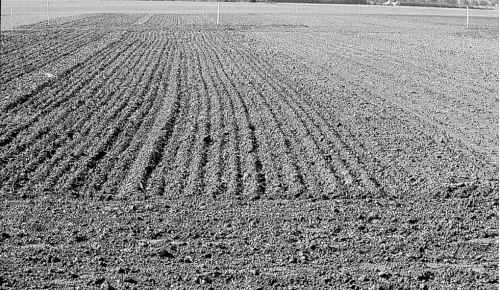
Figure 8a. Before rolling.
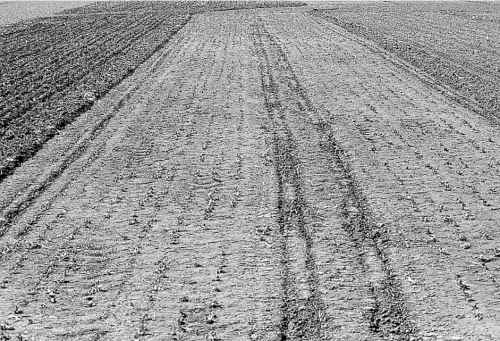
Figure 8b. After rolling.
Researchers have examined opener, packer wheel and packing force and the effect on yield of direct seeded field pea at three locations from 1997 to1999. The study provided information on opener and on-row packing combinations as well as packing force.
In comparing packing forces in Newtons (N) of 0N, 333N, 549N, 747N and 1000N, Johnson et al found the response to packing force on seedling density and grain yield was insignificant. The work suggested the benefits of packing the seed on-row may be minimal in a moist seedbed, but in drier and wetter than normal conditions, some packing may improve crop emergence and yield. In 1997, pea emergence was reduced with no packing force in a relatively dry seedbed.
Reinforcing these findings is a separate study by Hultgreen, 1990, that showed a positive response to packing at sites with loam to clay soil textures. These sites were under periodic drought with heat and wind stress.
Table 1shows the approximate lbs/ft2 of a steel cylinder roller with varying diameters and water ballast.
Table 1. Land roller weight chart
Ground pressure (lbs/ft2)
(based on 1 foot of ground contact)* |
| Roller diameter | Empty** | Half full (H20) | Full (H20) |
| 24 inches | 200 to 225 | 290 to 315 | 380 to 405 |
| 30 inches | 250 to 275 | 395 to 420 | 540 to 565 |
| 36 inches | 300 to 325 | 510 to 535 | 715 to 740 |
| 42 inches | 350 to 375 | 640 to 665 | 920 to 945 |
* Ground pressure increases with narrower bearing surface
(e.g. no-till) and decreases with wider bearing surface
(e.g. fallow)** Empty weight depends on frame design, steel thickness, number/size of transport wheels, hydraulics, etc.
Source: Wayne Winchell, Agricultural Engineer, Alberta Agriculture and Food
Summary
Farmers should be careful not to double roll areas of the fields such as headlands because excessive plant damage and packing can occur from the tractor tires and in turning areas. Rolling the field round and round will eliminate this problem, although there will be areas of the field left unrolled.
If rolling fields back and forth, growers should slow down to make turns at the headlands and be careful not to use their brakes to turn. After the first half round trip around any field, the tractor operator should stop, get off the tractor and look at the job the land roller is doing.
If farmers wish to roll the field post-emergence, rolling should be done when the plants are slightly wilted and the soil surface is dry. Rolling should not be done on excessively wet, dry or sandy soils or when the crop is damp or stressed by extreme heat, frost or herbicide application. If practical, wait until the stress conditions subside before rolling - a minimum of two to three days.
Farmer experience in land rolling of pulses crops at later growth stages resulted in significant problems:
- damaged plants
- increased spread of foliar diseases
- reduced grain yield
For dry beans, farmers should pay close attention to the crop stage development. The hypocotyl hook structure of dry bean is quite fragile, and if the hook is within half an inch of the soil surface or the crop is 3 to 5 days after emergence, growers should not roll the crop.
When faced with the post crop emergence decision as to whether to spray early or roll early, growers should know that spraying first is recommended, as opposed to rolling first. Early weed removal, especially under higher weed pressures, will result in higher yields.
Blair Roth, a long-time Special Crops Agrologist with Agricore United, in Lethbridge, best sums up the question on land rolling pulses post-emergence: "When it comes to rolling fields, make sure you are imposing no more than one stress on the pulse crop at any one time."
References
Harker, H. N., Clayton, G.W., and Blackshaw, R.E., 2001. Timing of weed removal in field pea (pisum sativum). Weed Techno.15:277-283.
Johnston, A. M., Lafond, G. P., May, W. E., Hnatowich, G. L., and Hultgreen, G. E., 2002. "Opener, packer wheel, and packing force effects on crop emergence and yield and yield of direct seed wheat, canola, and field peas" Can. J. Plant Sci. pp.129-139.
Klassen, E.P. and Watts, J., 1998. "Effects of rolling a clay loam field, to press in stones on dry edible bean and dry pea production" in Progress Reports on Pulse Research in Western Canada. 3:15-16.
Lopetinsky, K. J., and APGC-Zone 3.,1993. FFF-OFD #93-F001-5. "Demonstration and Technology Transfer of Pulse Crop Agronomics in North Central Alberta". Barrhead, Alberta
Park, B., and Lopetinsky, K. J., (eds)., 1999. "Pulse Crops in Alberta." Alberta Agriculture and Food, Edmonton, Agdex 142/20. Edmonton, Alberta
Olson, M.A., 2003. "Personal telephone conversation with Blair Roth of Agricore United." Edmonton, Alberta.
Saskatchewan Pulse Growers. 2000. "Saskatchewan Pulse Manual." pp 6.15, 7.12, 8.9, and 9.13.
Whatley, N. 1993. Evaluation of seeding rates and post-emergent land rolling for lentil production. Project D-89-CP-0690. Agriculture Development. Saskatchewan Agriculture and Food.
Prepared by:
- Mark Olson, Provincial Pulse Industry Development Specialist, Alberta Agriculture and Rural Development, Edmonton, Alberta.
- Ken Lopetinsky, Pulse Research Agronomist, Alberta Agriculture and Rural Development, Barrhead, Alberta.
- Wayne Winchell, Agricultural Engineer, Alberta Agriculture and Rural Development, Barrhead, Alberta.
- Carol Sauchuk, Private Consultant, Waskatenau, Alberta.
Edited and reviewed by
- Ray McVicar, Provincial Specialist Special Crops, Saskatchewan Agriculture, Food & Rural Revitalization, Regina, Saskatchewan.
- Bruce Brolley, Pulse Crops Specialist, Manitoba Agriculture and Food and Rural Initiatives,Carman, Manitoba.
- Karla Bergstrom, Crop Specialist, Ag-Info Centre, Alberta Agriculture and Rural Development, Stettler, Alberta.
Source: Agdex 142/21-1. June 2004. |
|